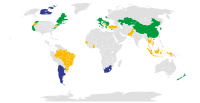Carbon price

Alright, kiddo, let me try to explain carbon price to you. You know how we all use energy every day to do things like drive cars, turn on lights, cook food, and use our computer or iPad, right? Well, most of the energy we use comes from burning fossil fuels like oil, gas, and coal. When we burn these fossil fuels, it releases carbon dioxide (CO2) into the air. CO2 is a greenhouse gas, which means it traps heat and warms up the Earth's atmosphere, causing climate change.
So, some countries and governments want to reduce the amount of CO2 we release into the air. They think that if we make it more expensive to use fossil fuels by charging a certain amount of money for each ton of CO2 produced, people will start using less fossil fuels or find ways to reduce their carbon footprint.
To do this, they put a price on carbon. The price is a kind of tax, but instead of going into the government's general funds, it goes to programs and projects that help reduce carbon emissions. This makes products and services that are produced with more CO2 emissions more expensive, and products and services that are produced with fewer CO2 emissions cheaper in comparison.
For example, if a company produces electricity using natural gas, it will now have to pay a carbon tax for each ton of CO2 it emitted. If the company switches to renewable energy like solar or wind, it will pay less or no tax and can even sell excess clean energy to other companies.
So, in simpler words, carbon price is a way to discourage people and companies from using fossil fuels and encourage them to use cleaner forms of energy by making it more expensive to use them, which can help protect our planet and reduce climate change.
So, some countries and governments want to reduce the amount of CO2 we release into the air. They think that if we make it more expensive to use fossil fuels by charging a certain amount of money for each ton of CO2 produced, people will start using less fossil fuels or find ways to reduce their carbon footprint.
To do this, they put a price on carbon. The price is a kind of tax, but instead of going into the government's general funds, it goes to programs and projects that help reduce carbon emissions. This makes products and services that are produced with more CO2 emissions more expensive, and products and services that are produced with fewer CO2 emissions cheaper in comparison.
For example, if a company produces electricity using natural gas, it will now have to pay a carbon tax for each ton of CO2 it emitted. If the company switches to renewable energy like solar or wind, it will pay less or no tax and can even sell excess clean energy to other companies.
So, in simpler words, carbon price is a way to discourage people and companies from using fossil fuels and encourage them to use cleaner forms of energy by making it more expensive to use them, which can help protect our planet and reduce climate change.
